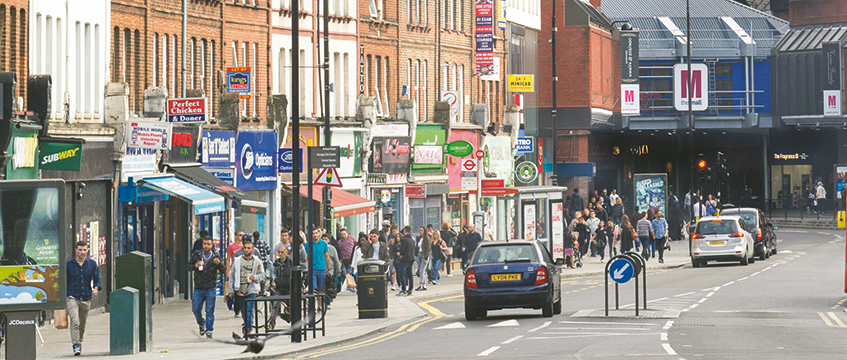When Simple Minds sang Don’t you forget about me, chances are they were not singing from the perspective of UK high streets. But they could have been. Despite their presence across the country, high streets seem to be a blip outside many retailers’ radars, which tend to be directed at shopping centres, retail parks and online shopping. Does that mean there is a gap in the market?
A survey of 510 people on three UK high streets – Leighton Buzzard, Market Harborough and Rotherham – looked at shoppers’ behaviour, crunching the numbers to see whether there is still any appetite among residents to shop in these places. It revealed that not only is there appetite to keep shopping on high streets, residents want more.
“People still like convenience, and if you’ve got more opportunity – more retailers – at your doorstep, people will still spend there,” says Antony Francis, client manager at ESA SiteWatch, which carried out the survey.
The company chose the three high streets as examples of average shopping locations in the UK – Leighton Buzzard in the south, Market Harborough in the Midlands and Rotherham in the north. Each of these has a shopping centre nearby that acts as an alternative to the high street. ESA SiteWatch asked passers-by how much time and money they spend in either location, what is missing from their high streets and whether they could be persuaded to shop there more often.
In all three areas, two-thirds of respondents said they visited the high street at least a few times a week, if not more. But their habits do differ.
Nearly all of Leighton Buzzard’s frequent visitors spend money on the high street just as frequently, and the daily visitors on average spend more than their counterparts in Rotherham or Market Harborough – at £13.03 for groceries and £17.67 on other things. The opportunity comes from the fact that 80% of respondents who said they shopped in Milton Keynes did so because the shopping centre had retailers the high street lacks.
Francis says: “What Leighton Buzzard needs to make sure is that it’s not losing out to everyone going off to Milton Keynes because of these retailers not being there.
“If they were on the high street, the propensity to shop in Leighton Buzzard would be higher and they would spend more money.”
In Rotherham, that opportunity is even greater. Only half of the daily visitors surveyed said they shopped there daily, which means that if the right retailers come in they might be enticed into spending more. More than 40% of respondents said they would shop more on the high street if there was more choice. That is particularly telling considering 49% of visitors already go to Rotherham to shop and one in five travel more than 20 minutes to get there.
The flipside of that is Market Harborough, which Francis calls an “atypical” high street. While only half of daily visitors spend money there daily, they did not seem dissatisfied with what was on offer. More than a third of respondents did not visit their shopping centre in High Cross – the highest percentage among the three areas – suggesting that there might not be a gap to fill with new retailers.
Even if the new retailers that respondents found appealing – including Pret a Manger, Asda and John Lewis – came to Market Harborough, only 14% of them said they would shop more frequently.
What do customers want?
In each of the three areas, people wanted more of the same: more options in the same kinds of shops that brought them to the high street to begin with. Leighton Buzzard’s shoppers predominantly go there for groceries, lunch and clothes, and the retailers they want the most are Lidl, John Lewis, H&M and Pret a Manger. Two-thirds of Market Harborough shoppers go there for groceries and coffee shops. Unsurprisingly, the top of their retail wish list includes Asda and Pret a Manger.
In fact, half of all respondents in Leighton Buzzard and Market Harborough – along with a quarter in Rotherham – wanted a Pret a Manger in their area.
Francis says: “Interestingly, the further you go north, the lower the number. It might be that up in Rotherham fewer people are aware of Pret, whereas in the Midlands and closer to London people are very aware of it.
“Although people have tightened their belts over the past few years or so, they are willing to spend money on good food, and Pret is a bit more of an upmarket lunch retailer. Generally, people are willing to go there and want to spend their money because the quality of the food is very good. Those types of retailers are starting to radiate out from the London area.”
Shoppers also gravitated toward department stores such as John Lewis and Debenhams, which might be too big to fit on the average high street.
Francis says: “It’s not necessarily something you can have on the high street. But potentially, there may be a smaller spin-off type store that might be focused on home products.”
Regardless of the approach, Francis suggests, these opportunities need to be taken. “People do want these retailers to be more local to them. If they were in the local area, they would shop there more frequently, be spending more money and at the same time help the local economy,” he says, adding – as if to echo those old mid-80s lyrics: “The most important thing is for retailers not to forget the high street.”
To send feedback, e-mail karl.tomusk@egi.co.uk or tweet @ktomusk or @estatesgazette











